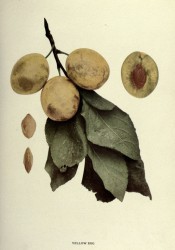Prunus domestica ‘White Magnum Bonum’
A Prunus domestica L. cultivar. ‘Fruit of the largest size, oval, with a rather deep suture extending the whole length of one side. Skin deep yellow, covered with thin white bloom. Stalk an inch long, inserted without depression. Flesh yellow, firm, coarse-grained, with a brisk subacid flavour, and adhering to the stone. Shoots smooth. A culinary plum, highly esteemed for preserving. Ripe in the beginning of September.’ [Hogg – Fruit Manual p.258/1860].
Horticultural & Botanical History
‘The references and synonyms show that Yellow Egg is a plum with an interesting history, but unfortunately the accounts of its origin and subsequent history have been but poorly preserved. Rea, in 1676, described the Yellow Egg as the Bonum Magnum or Dutch Plum; we may infer from this that the English obtained the variety from Holland. Knoop of Holland, in 1771, described the variety under the name Prune d'Oeuf Blanche, indicating a French origin. Knoop describes the Prune De Monsieur as similar and this plum has ever since been held as doubt fully identical. Duhamel, in Traite des Arbres Fruitiers, 1768, described Yellow Egg as the Dame Aubert. Kraft in Pomona Austriaca, 1796, gave it as the Die Grosse Weisse Glanzende, oder Die Albertus Damenpflaume. These references show that Yellow Egg was well known at an early date. Because of its close resemblance to many varieties, probably due to the propagation of seedlings from it, much confusion exists in the nomenclature of Yellow Egg. White Imperial was separated by Duhamel and Prince; but Miller, Thompson and most of the subsequent writers give it as the same. Duhamel believed the Imperial Blanche (White Imperial) to be the Grosse Datte. So, too, the Wentworth was at first separated but, later, was recorded as identical. Koch calls Yellow Egg one of the Datterpflaumen (Date Plums) though he states that there is another Date Plum known by Tragus more than three hundred years ago as Prunidactyla. De Candolle seems to hold to the names Dame d'Aubert and Aubertina for this plum. Professor Budd in exploring southwest Russia and Poland found a Dame Aubert differing from our Yellow Egg only in minor characters which he was told came from central Asia.’ [Plums of New York p.386 as ‘Yellow Egg’].
‘Flesh yellow, firm, closely adhering to the stone. Juice acid, not fit to be eaten raw, but excellent for sweetmeats.’ [George Lindley – Orchard Guide p.469/1831].
Also figured in Pomona Britannica [PB pl.XVII/1812].
History at Camden Park
Listed in all published catalogues as ‘White magnum bonum’ [Plum no.5/1843].
Notes
Published May 27, 2010 - 01:55 PM | Last updated Jul 22, 2011 - 10:35 AM
| Family | Rosaceae |
|---|---|
| Category | |
| Region of origin | Garden origin, probably France |
| Synonyms |
|
| Common Name | Culinary Plum, autumn |
| Name in the Camden Park Record |
White magnum bonum
|
| Confidence level | high |


